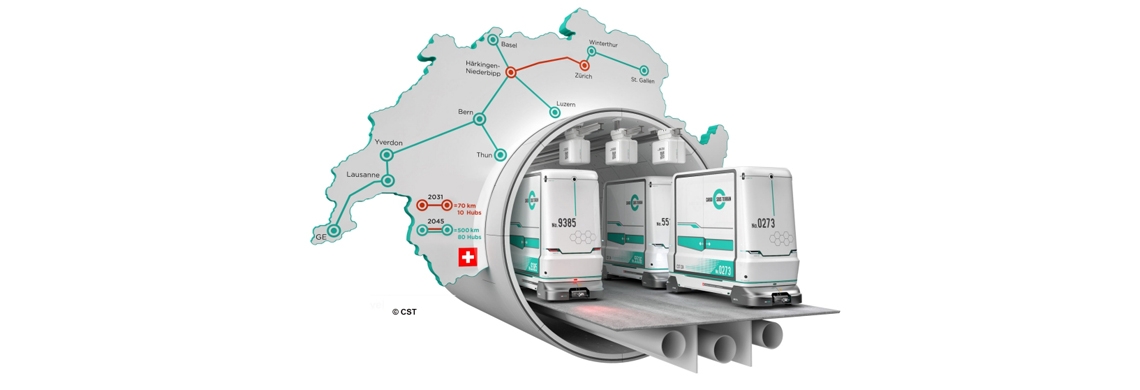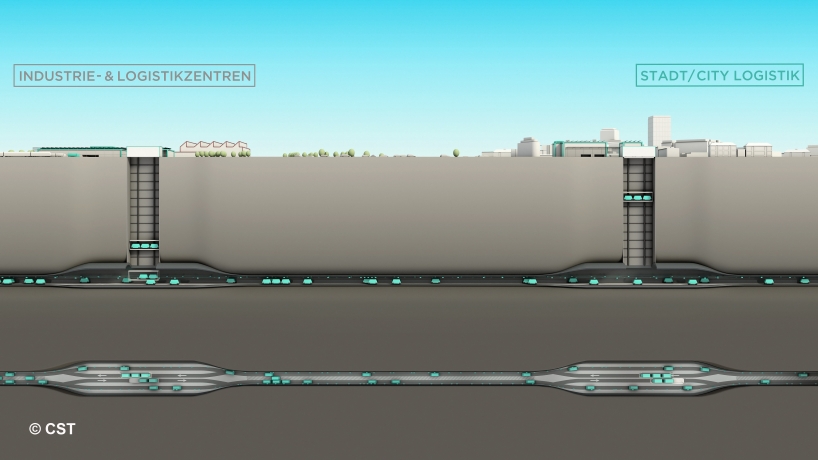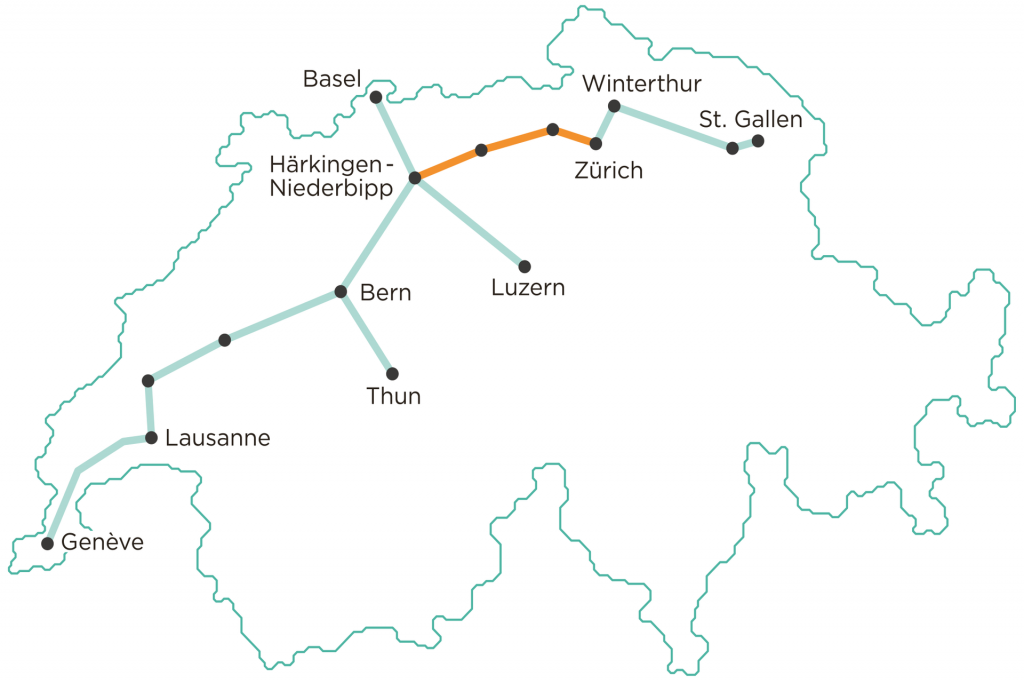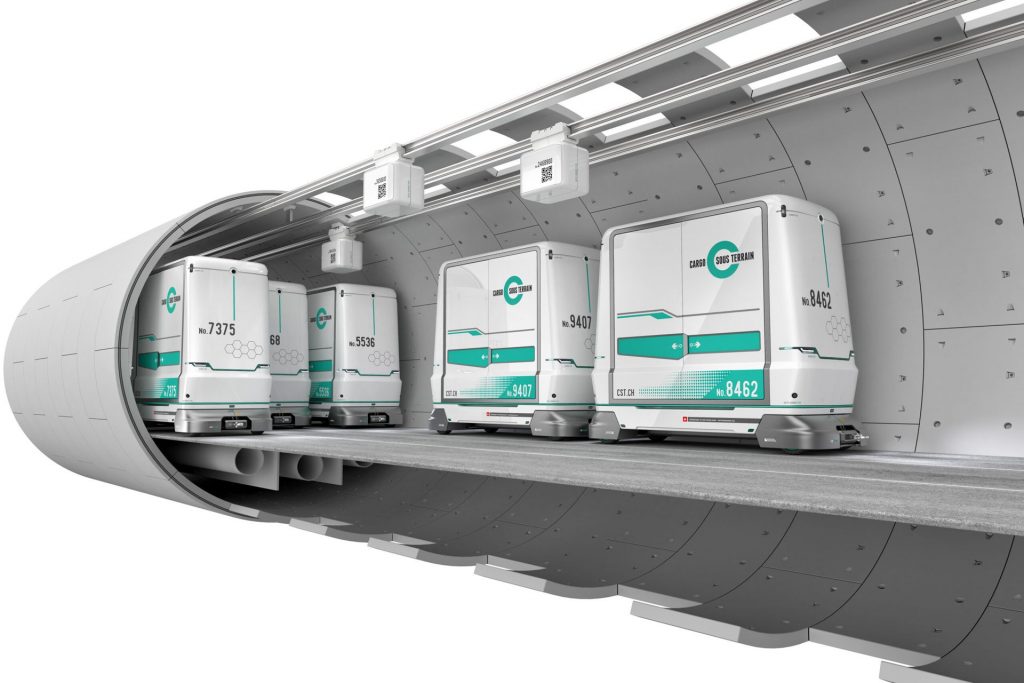Switzerland’s innovative underground logistics project takes shape
Cargo sous terrain (CST) has reached the first milestones to develop the entire Swiss network, which is expected to be ready by 2045 in cooperation with cities and cantons while the first section from Härkingen to Zurich Airport will open in 2031.

With the positive parliamentary decision at the end of 2021, investor funds for the CST have become available for the construction authorization phase, which includes preparing the necessary approval procedures in the cantons along the first section of the tunnel. In the cantons of Aargau, Solothurn and Zurich, the procedures for the structural plan, which are the prerequisite for the CST, will begin at the end of 2022. At the current stage, the most suitable locations for the hubs along the first section from Härkingen to Zurich Airport are being studied, examining traffic accessibility and carrying out geological clarifications with the aim of integrating the hub into the landscape and inhabited area. This innovative profect will go a long way toward reducing the volume of surface freight traffic. Parallel to the planning of the first section, the CST is also working on the extension of the entire Swiss network by 2045.
Eastern Switzerland wants a fast connection to the CST
The study conducted by CST together with the cantons of St. Gallen and Thurgau of the feasibility potential of underground freight transport between Zurich and eastern Switzerland showed that extending the network to St. Gallen is technically and economically promising. Based on the results, more in-depth investigations of possible hub locations are now being conducted, and both cantons are working to develop the fastest possible connection to the future-oriented system.

In the joint study, projected freight volumes were determined and possible areas for a surface connection point were defined while also taking into consideration major regional development projects. The analyses show that the freight volumes in Frauenfeld, Weinfelden, Wil, Uzwil, Gossau Ost, St. Gallen and St. Margrethen would in principle justify the construction of a connection point. With this project, surface freight traffic can be moved underground, reducing pressure on infrastructure expansion.
Technical Data
The tunnel for the innovative logistics system will have a depth of 50 to 80 meters. Examination of technical feasibility included identification of possible conflicts with groundwater deposits and investigation of rock type. Both are critical to the success of the tunnel where it was found that groundwater areas can be largely undercut and thus any compromise of groundwater by the tunnel can be avoided. Between Winterthur and St. Gallen, specialists foresee geological conditions suitable for tunnel construction while between the east of the city of St. Gallen and the Rhine Valley, the subsurface is more challenging since this is already a peripheral area of the Alps.
Economic potential
The extension of the network to Frauenfeld, Wil, Uzwil, Gossau, and St. Gallen has economic investment potential while the extension of the tunnel to the Rhine valley involves high construction costs, which probably cannot be sufficiently covered by the freight potentials to be developed in the Rhine valley of St. Gallen and Vorarlberg. The connection to Weinfelden also appears uneconomic at present.
In Switzerland the transport of goods will “slide” underground
Promising potential in French-speaking Switzerland
A feasibility study in cooperation with the cantons of Vaud and Geneva also confirmed the economic viability of a connection to the comprehensive CST network in French-speaking Switzerland. The partial shift of road freight traffic underground also brings significant ecological benefits to Lake Geneva. The overall result is improved quality of life and public health in the region.
Infographic of the vertical section of one of Cargo Sous Terrain’s connecting tunnels in Switzerland
Zurich: traffic reduction in the city and airport
A few days ago, CST AG signed a “Memorandum of Understanding” with Flughafen Zürich AG (FZAG), which has held a stake in CST since 2019 to connect the airport with the first section in order to relieve access roads while controlling logistics flows. In terms of construction, this will be accomplished with a branch of the main tunnel: CST is providing the tunnel and vertical conveyors, while FZAG builds the actual logistics terminal building.
SalüBox
In the city of Zurich, CST is supporting municipal authorities in a pilot parcel storage and collection project called “SalüBox” intended to bundle the booming parcel delivery traffic and relieve residential neighborhoods of delivery traffic. Local businesses and merchants will also be able to use the SalüBox to deposit goods. This partnership is part of CST-Citylogistik’s efforts to reduce urban traffic and pollutant emissions even before the tunnel goes into operation, improving everyone’s quality of life, and in four parts of the city area it is expected to start in the fall.
Network
The first section of the Cargo sous terrain network runs from Härkingen-Niederbipp to Zurich and is about 70 kilometers long. There are 10 connection points (hubs) on this section. Expansion to other major logistics and distribution centers in Switzerland will take place later and by 2045, a 500-kilometer network will be created between Lake Constance and Lake Geneva, with branches to Basel, Lucerne and Thun. Total costs for the construction of the first section from Härkingen-Niederbipp to Zurich, including software, hubs and underground and ground vehicles (for urban logistics) are estimated at 3 billion francs.

Fonte: cst.ch






